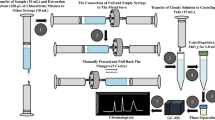Abstract
The distribution and elimination of di-2-ethylhexyl phthalate (DEHP) and mono-2-ethylhexyl phthalate (MEHP) after a single oral administration of DEHP (25 mmol/kg) were studied. A gas-liquid Chromatographic method was used for the simultaneous determination of MEHP and DEHP. The compounds were extracted with methylene chloride and the monoester was alkylated to the hexyl derivative by solid-liquid phase transfer catalysis in methylethyl ketone. The coefficients of variation of this method for determination of DEHP and MEHP were 8.3% and 11.4% respectively. The concentration of DEHP and MEHP in blood and tissues increased to maximum within 6–24 h after dosing, while the highest levels observed in the heart and lungs occurred within 1 h. At 6 h after administration, the highest ratio of MEHP/DEHP (mol%) were recorded in testes (210%) while the other tissues exhibited less than 100%. MEHP disappeared exponentially with t 1/2 values ranging from 23 to 68 h; DEHP t 1/2 ranged from 8 to 156 h and the t 1/2 values of MEHP in several tissues were slightly longer than DEHP. The t 1/2 values in blood were 23.8 h and 18.6 h for MEHP and DEHP, respectively.
Similar content being viewed by others
References
Albro PW, Thomas R (1973) Enzymatic hydrolysis of di(2-ethylhexyl) phthalate by lipase. Biochim Biophys Acta 306: 380–390
Albro PW, Thomas R, Fishbein L (1973) Isolation and characterization of the urinary metabolism of diethylhexyl phthalate by rats. J Chromatogr 76: 321–330
Arbin A, Ostelius J (1980) Determination by electron-capture gas chromatography of mono-and di(2-ethylhexyl) phthalate in intravenous solutions stored in polyvinyl chloride bags. J Chromatogr 193: 405–412
Carter J, Roll DB, Petersen RV (1974) The in vitro hydrolysis of di(2-ethylhexyl) phthalate by rat tissue. Drug Metab Dispos 2: 341–344
Cater BR, Cook MW, Gangolli SD, Grasso P (1977) Studies on dibutyl phthalate-induced testicular atrophy in the rat: effect on zinc metabolism. Toxicol Appl Pharmacol 41: 609–618
Chu I, Villeneuve DC, Secours V, Franklin C, Rock G, Viau A (1978) Metabolism and tissue distribution of di-(2-ethylhexyl) phthalate in rats. Drug Metab Dispos 6: 146–149
Daniel JW, Bratt H (1974) The absorption, metabolism and tissue distribution of di-(2-ethylhexyl) phthalate in rats. Toxicology 2: 51–65
Foster PMD, Thomas LV, Cook MW, Gangolli SD (1978) Studies of the testicular effects and changes in zinc excretion produced by some n-alkyl phthalate in the rat. Toxicol Appl Pharmacol 54: 392–398
Gray TJB, Butterworth KR, Gaut IF, Grasso GP, Gangolli SD (1977) Short-term toxicity of di-(2-ethylhexyl) phthalate in rats. Food Cosmet Toxicol 15: 389–399
Hillman LS, Goodwin SL, Sherman WR (1975) Identification and measurement of plasticizer in neonatal tissues after umbilical catheters and blood products. N Engl J Med 292: 381–386
Hites RA (1973) Analysis of trace organic compounds in New England rivers. J Chromatogr 11: 570–574
Ikeda GJ, Sapienza PP, Couvillion JL, Farber TM, van Loon EJ (1980) Comparative distribution, excretion and metabolism of di-(2-ethylhexyl) phthalate in rats, dogs and miniature pigs. Food Cosmet Toxicol 18: 637–642
Jeager RJ, Rubin RJ (1970) Plasticizers from plastic devices: excretion, metabolism and accumulation by biological systems. Science 170: 460–462
Jeager RJ, Rubin RJ (1972) Migration of a phthalate ester plasticizer from polyvinyl chloride blood bags into stored human blood and its localization in human tissues. N Engl J Med 287: 1114–1118
Jeager RJ, Rubin RJ (1973) Excretion, localization and metabolism of di-2-ethylhexyl phthalate from PVC plastic medical devices. Environ Health Perspect 3: 95–102
Lawrence WH, Tuell SF (1979) Phthalate esters: the question of safety-an update. Clin Toxicol 15: 447–466
Oishi S, Hiraga K (1975) Toxicity of di-2-ethylhexyl phthalate in rats. Tokyo Eiken Nempo 26: 131–138 (in Japanese)
Oishi S, Hiraga K (1980a) Testicular atrophy induced by phthalic acid esters: effects of zinc and testosterone concentrations. Toxicol Appl Pharmacol 53: 35–41
Oishi S, Hiraga K (1980b) Testicular atrophy induced by phthalic acid monoesters: effects of zinc and testosterone concentrations. Toxicology 15: 197–202
Overturf ML, Druihert RE, Liehr JG, Kiekendall WH, Caprioli RM (1979) Phthalate esters in normal and pathological human kidneys. Bull Environ Contam Toxicol 22: 536–542
Peakall DB (1975) Phthalate esters: occurence and biological effects. Residue Rev 54: 1–41
Rock G, Secours VE, Franklin CA, Chu I, Villeneuve DC (1978) The accumulation of mono-2-ethylhexyl phthalate (MEHP) during storage of whole blood and plasma. Transfusion 18: 553–558
Rowland IR, Cottrell RC, Philipps JC (1977) Hydrolysis of phthalate esters by the gastrointestinal contents of the rat. Food Cosmet Toxicol 15: 17–21
Schulz CO, Rubin RJ (1973) Distribution, metabolism and excretion of di(2-ethylhexyl) phthalate in the rat. Environ Health Perspect 3: 123–130
Shibko SI, Blumenthal H (1973) Toxicology of phthalic acid esters used in food-packing materials. Environ Health Perspect 3: 131–137
Tanaka A, Adachi T, Takahashi T, Yamaha T (1975) Biochemical studies on phthalic acid esters. I. Elimination, distribution and metabolism of di-(2-ethylhexyl) phthalate in rats. Toxicology 4: 253–264
Thomas JA, Darby TD, Wallin RF, Garvin PJ, Marts L (1978) A review of the biological effects of di-(2-ethylhexyl) phthalate. Toxicol Appl Pharmacol 45: 1–27
Ulsaker GA, Hoem RM (1978) Determination by gas chromatography-single-ion monitoring mass spectrometry of phthalate contaminants in intravenous solutions stored in PVC bags. Analyst 103: 1080–1083
Vessman J, Rietz G (1978) Formation of mono(ethylhexyl) phthalate from di(ethylhexyl) phthalate in human plasma stored in PVC bags and its presence in fractionated plasma proteins. Vox Sang 35: 75–80
Williams DT, Blanchfied BJ (1974) Retention, excretion and metabolism of phthalic acid administered orally to the rat. Bull Environ Contam Toxicol 11: 371–378
White RD, Cater DE, Ernst D, Mueller J (1980) Absorption and metabolism of three phthalate diesters of the rat small intestine. Food Cosmet Toxicol 18: 383–386
Author information
Authors and Affiliations
Rights and permissions
About this article
Cite this article
Oishi, S., Hiraga, K. Distribution and elimination of di-2-ethylhexyl phthalate (DEHP) and mono-2-ethylhexyl phthalate (MEHP) after a single oral administration of DEHP in rats. Arch Toxicol 51, 149–155 (1982). https://doi.org/10.1007/BF00302755
Received:
Issue Date:
DOI: https://doi.org/10.1007/BF00302755




